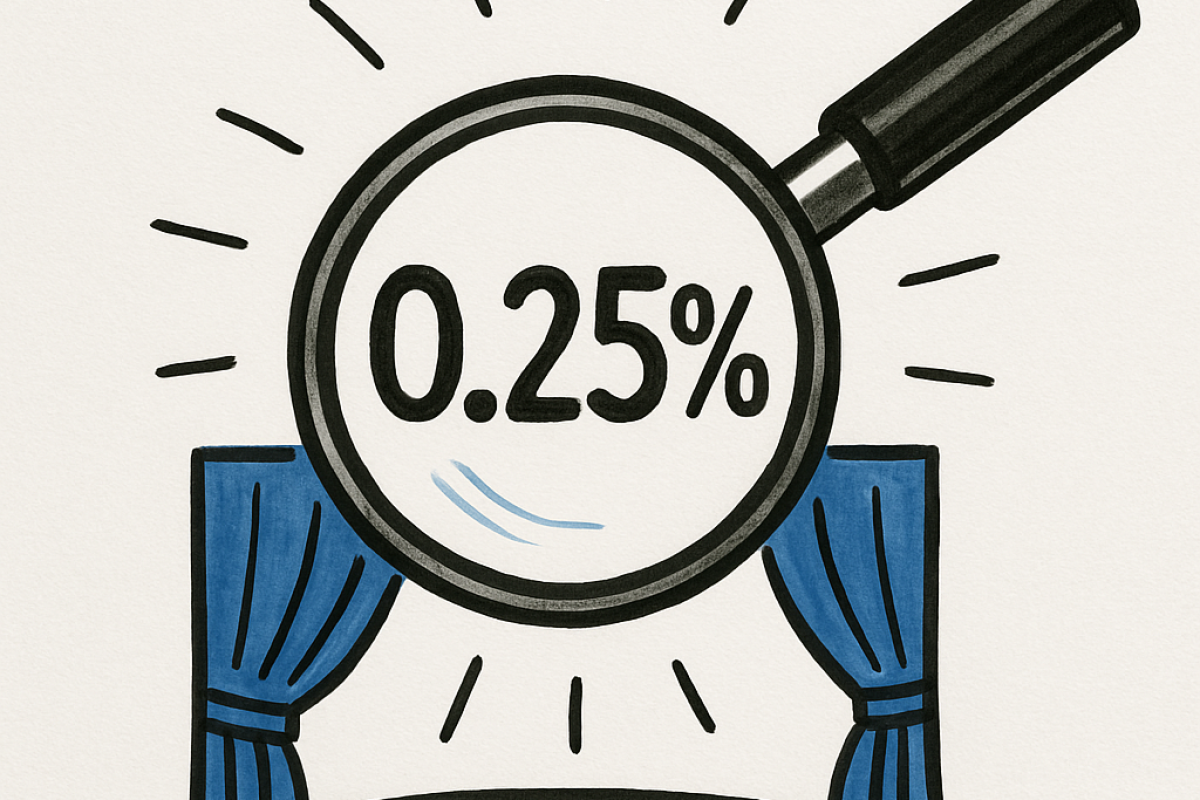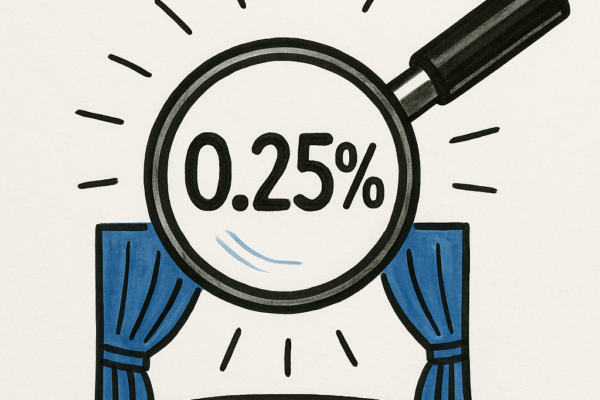The Market’s (er, Media’s) Obsession with 25 Basis Point Moves
Every time the Federal Reserve is about to tweak its policy rate by a quarter of a percent, the investment world seems to hold its collective breath. Once the (typically much telegraphed) outcome is made public, markets surge or sink, pundits dissect the Fed statement like theologians parsing ancient scripture, and headlines flash with urgency. The question I am increasingly asking myself is: Is this reaction warranted?
Maybe we are assigning too much importance to what is, in essence, a 0.25% adjustment? Does the move matter because it actually changes the economic trajectory—or because it’s interpreted as a signal? And if it’s been anticipated for weeks, how many times can “the market” price in the same information?! Let’s dig into why the investment community may be overly fixated on these micro-movements—and why a 25bps change might deserve a little less drama and a little more perspective.
What Is a 25bps Move, Really?
To put it plainly: one 25 basis point move is not a policy overhaul. It’s a nudge… a slight nudge. In most economic environments, such a shift is akin to adjusting the office thermostat lower by one degree (maybe even less). Yes, technically there’s a change. But is anyone reaching for their coat? While the Fed certainly wants to guide inflation, employment, and credit conditions, the marginal utility of each additional 25bps move diminishes, especially after several hikes or cuts in succession.
The Fed’s real influence in these small moves isn’t necessarily in the cost of capital—it’s in the message being sent. A 25bps hike can be interpreted as: “We think inflation risks persist.” Or, a 25bps cut might imply: “We’re seeing cracks in the labor market.” But the moves themselves rarely shock anyone—by the time the Fed announces them, markets have been anticipating them for weeks or months.
Recent Industry Commentary on this Topic:
BlackRock notes that markets tend to front-run the Fed: “Investors have priced in rate cuts well before they occur… so the actual cut itself may not deliver much” (BlackRock, 2025a; Reuters, 2025).
Invesco recently commented that “policy cuts may not stimulate demand as strongly as in past cycles,” due in part to slower transmission and the fact that corporations and households locked in low borrowing costs in prior years (Invesco, 2025).
- Reuters and Kiplinger have both highlighted how a widely expected 25 bps cut may have minimal market impact, with the real volatility coming from forward guidance or unexpected language shifts in the Fed’s statement (Reuters, 2025; Kiplinger, 2025).
In other words, the move is often just the punctuation mark. The sentence was written well in advance.
How Many Times Can the Same Move Be Priced In?
Apparently: more times than you’d expect. The market is a forward-looking apparatus. The CME FedWatch tool, yield curves, and derivative pricing all digest future rate expectations constantly. When the probability of a rate change hits 80% or higher ahead of a Fed meeting, the actual announcement becomes, essentially, a formality. In our current environment, a 25bps cut that was 90%+ priced in rarely causes much more than a shoulder shrug—unless paired with unexpected rhetoric or a key metric shift.
Academic Perspective
Economic research supports the idea that market responses to small rate moves often reflect the signaling effect, rather than the raw mechanics of a quarter-point change. The research helps to explain that rate changes act as public signals to economic agents with incomplete information, affecting expectations more than fundamentals and that most of the asset-price reaction around central bank announcements is tied to revised expectations—not the rate itself. In other words: the market listens to the Fed not for what it does, but for what it implies about the road ahead.
This analogy may fall short but… imagine your cardiologist adjusts your pacemaker by 0.25 beats per minute and then looks at you dramatically, as if they just saved your life. Are you grateful? Do you change all of your travel (or estate) plans in the coming weeks? Or, are you left thinking… seriously? A 25bps Fed move is a bit like that. Yes, it matters—especially if the system is unstable—but if the economic heart is beating more or less normally, a minor tweak (a veryminor tweak) isn’t going top move the needle. It’s just a fine-tuning gesture. But the drama? That comes from the over-analysis, not the actual voltage.
Implications for Investors
So what should disciplined investors do with this perspective?
- Look past the headline: Focus on what the Fed is saying about inflation, employment, and broader conditions—not just the number of basis points.
- Watch the guidance: Forward-looking language, dot plots, and speeches often drive more movement than the policy rate itself.
- Be skeptical of overreaction: If a move has been anticipated for months, the odds of a market-moving surprise are low. Consider whether volatility is justified.
- Keep the broader picture in mind: Monetary policy is just one input. Fiscal spending, geopolitical shifts, labor force trends, and consumer behavior all influence outcomes in ways that make 25bps moves look relatively small.
Final Point
The Federal Reserve can play an important role in guiding economic stability or stimulating growth. But the investment community may be guilty of attributing too much importance to every tiny move in the Fed funds rate—especially when the shift has already been telegraphed, priced in, and dissected for weeks in advance. To be clear, it is not that 25bps doesn’t matter. It’s that the reaction to 25bps often tells us more about the market’s emotional state than the economy’s. As always, true investment discipline means filtering noise from signal—and recognizing that sometimes, the biggest headlines may not be in the most important.
Reference List
BlackRock. (2025a, September 16). Not all cuts are equal. BlackRock. https://www.blackrock.com/us/financial-professionals/insights/not-all-cuts-are-equal
BlackRock. (2025b, September). Fed rate cuts and potential portfolio implications. BlackRock. https://www.blackrock.com
Invesco. (2025, September). Investment grade outlook: What would a rate cut mean? Invesco. https://www.invesco.com
Kiplinger. (2025, September). What will the Fed do at its next meeting? Kiplinger. https://www.kiplinger.com/investing
Reuters. (2025, September 18). Fed’s rate cut comes with caveats, leaving investors lukewarm. Reuters. https://www.reuters.com/world/us/feds-rate-cut-comes-with-caveats-leaving-investors-lukewarm-2025-09-18




